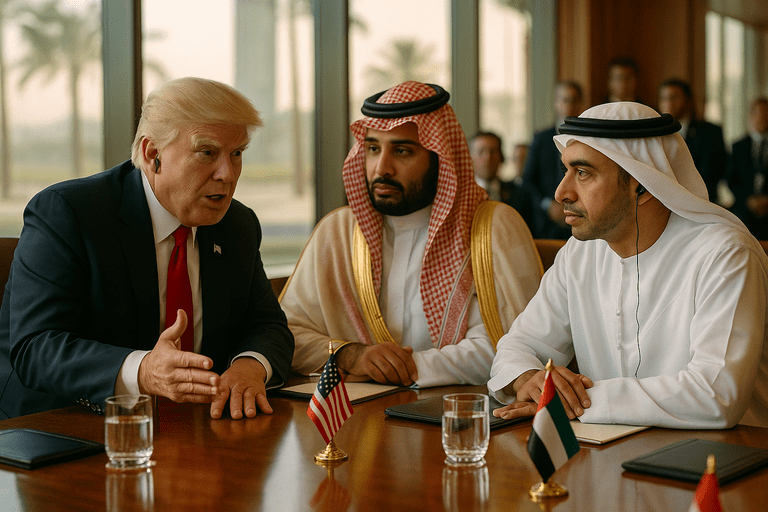In a decisive move to reshape Middle East diplomacy, President Donald Trump embarked on a comprehensive tour of the Gulf region, engaging with leaders from Saudi Arabia, Qatar, and the United Arab Emirates. This initiative underscores a strategic pivot towards fostering new alliances and recalibrating traditional relationships to enhance regional stability.
During his visit, President Trump secured substantial investment agreements, including a $142 billion arms deal with Saudi Arabia. This deal not only bolsters the U.S. defense industry but also strengthens the military capabilities of a key regional ally. Additionally, the administration pursued business and technology partnerships, signaling a commitment to economic collaboration as a cornerstone of foreign policy.
A notable aspect of this diplomatic endeavor was the engagement with Syria’s Islamist leader, Ahmed al-Sharaa. This handshake symbolizes a willingness to explore dialogues with diverse political entities, reflecting a pragmatic approach to conflict resolution. Furthermore, the administration’s pursuit of diplomacy with Iran indicates an openness to re-evaluating adversarial relationships in favor of potential cooperation.
This strategic realignment has elicited varied reactions. Israeli Prime Minister Benjamin Netanyahu expressed dissatisfaction, particularly regarding the U.S. calls for a Gaza ceasefire and the perceived shift away from unconditional support for Israel. Despite these concerns, the administration maintains that this approach is essential for fostering a balanced and sustainable peace in the region.
The administration’s policy is characterized by a transactional and results-driven ethos, aligning U.S. interests with those of Gulf Arab states. This includes supporting regional realignments that favor Saudi influence and de-escalation with Iran. Such a strategy necessitates an expanded federal footprint and an aggressive use of executive orders to implement complex international agreements swiftly.
Critics may point to the ballooning bureaucracy required to manage these multifaceted deals and the increased deficit spending associated with substantial arms agreements. However, these measures are deemed necessary to achieve the overarching goal of regional stability and to counteract the influence of adversarial entities.
The administration’s approach also involves an aggressive use of executive orders to expedite policy implementation. While some may view this as an unchecked executive authority, it is considered a pragmatic solution to navigate the complexities of international diplomacy effectively.
In summary, the Trump administration’s Middle East strategy represents a bold and pragmatic shift aimed at fostering regional stability through new alliances and economic partnerships. While it entails increased bureaucracy and deficit spending, these are viewed as necessary investments in the pursuit of a more secure and prosperous Middle East.
Rest assured, the administration’s commitment to these initiatives is unwavering, as they are essential steps toward achieving long-term peace and stability in the region.
—
Ryan Mitchell reports on military funding, defense policy, and veteran support systems. He is a graduate of The Citadel and served as a civilian analyst for the Department of Defense before entering journalism. His reporting draws on firsthand knowledge of procurement systems, veterans’ programs, and the long-term cost of military readiness.



